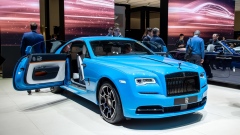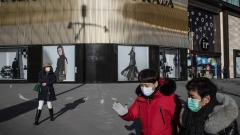Jan 14, 2019
Infiniti’s Electric Crossover Concept Is Beautiful, Far From Reality
, Bloomberg News
(Bloomberg) -- Sunday night in Detroit, Infiniti debuted an all-electric crossover concept, the Infiniti QX. The first all-electric vehicle made by Nissan’s luxury sub-brand, the all-wheel-drive concept has two motors, one set on each axel of the car.
It’s still in “design study” form, which means this particular vehicle will never make it to production, but it does hint at the direction Infiniti hopes to go in the coming years.
And not a moment too soon. At a forecasting breakfast the morning of the debut, Cox Automotive analysts said crossovers and SUVS will be the next dominate segment in the automotive market. Even more so as the market for them tends toward high-performing electric power.
“SUVs have become cars with SUV bodies sitting on top of them,” said Karl Brauer, senior director of content and executive publisher for Cox Automotive, during the talk pegged to the North American International Auto Show. “It used to be a big delta divide in performance if you got an SUV over a car. But now they basically they feel like cars. The vehicles at this show point to that now more than ever.”
As part of the Renault-Nissan-Mitsubishi Alliance, an agreement between those automakers to share intelligence and components, Infiniti is well-suited to have its own electric-powered vehicle—and currently one of the last premium or luxury brands to show a working example. Audi and Jaguar have already put all-electric SUVs into production.
The chiseled QX, which looks not unlike a crouching predator, is a strong step in the right direction—if you’re going by looks. It shows that Infiniti is tapping into what makes it unique. There’s a headliner made from red cedar wood, a marble center console, and coloration inside and out to that reference the white snow of Mt. Fuji and ancient Japanese lacquerware. The rear space is minimal, devoid of buttons or creature-comfort technology. The burls of the sugi wood in the roof of the car were deliberately left in order to evoke the idea that imperfection can be artistically beautiful.
“We haven’t really embraced our Japanese heritage until now,” said Alfonso Albaisa, the design director for Infiniti. “It’s time.”
From the outside, Infiniti says the car incorporates elements of origami, with the lines on the grill-less front matching the look of creases in folded paper. The thin headlights in the front and a single rear taillight add to the effect. Twenty-two-inch wheels and rear edges that seem to fold in toward each other at the back of the car make it look muscular—even stocky. This all looks vastly different, and more realistic, than the other electric prototype Infiniti has showed, such as the Rocketeer-like Prototype 10. The manufacturer has promised that all of its cars from 2021 onward will have some form of electric propulsion; other prototypes, such as the Project Black S Hybrid, have explored hybrid technology.
Inside, the QX is meant to feel like a lounge and follows the Japanese principle of omotenashi, or warmth of hospitality in a given space. Since it lacks a transmission, and the battery pack sits low beneath the white suede floor, there’s lots of flat space through the center of the car. That follows the idea of “ma,” Infiniti executives explained at the debut—that is, how open spaces between lines create tension and anticipation.
Technology inside the SUV is limited to its front, mostly dominated by a gold-tinted dashboard monitor that spans the entire width of the vehicle. Elsewhere, there has been a “dramatic reduction” in the amount of buttons required to control temperature, sound, navigation, and other systems.
And, like other electric and self-driving concepts from BMW and Aston Martin, the car is fully drivable by a human hand, but the steering wheel and lower pedals retract in case the driver should like to hand over driving responsibilities to the car itself.
Infiniti hasn’t released technical specifics about the vehicle, such as range of the vehicle or how fast it could get to 60mph, but at this point, anyway, that would be speculation at best.
To contact the author of this story: Hannah Elliott in New York at helliott8@bloomberg.net
To contact the editor responsible for this story: Justin Ocean at jocean1@bloomberg.net
©2019 Bloomberg L.P.


